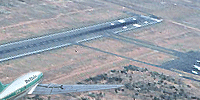 |
 |
|
||||
|
By
Wikipedia,
The Ape was a British biplane experimental aeroplane built by Armstrong Whitworth Aircraft in the early 1920s and first flown on 5 January 1926 to "answer all the questions of aerodynamics." DevelopmentThe aircraft was designed to be "infinitely" adjustable: The fuselage could be lengthened or shortened, different fins and tailplanes could be fitted, the incidence angle of both the tailplane and the wings could be altered and the wings could be additionally changed in stagger, rake and dihedral. It could not be converted to a monoplane configuration, nor be fitted with a more powerful engine. Additionally, the entire tail was a single unit and the incidence angle of the tailplane could not be changed without also changing that of the fin. It was equipped with a comparatively small 180 hp (130 kW) Lynx engine that did not deliver nearly as much power as the relatively heavy plane needed, and certainly prohibited the Ape from experimenting to its full potential. The second Ape had a bigger engine, the Bristol Jupiter, but additional gadgets added weight that mostly negated the extra power. The Ape would continue to see occasional use throughout the 1920s. OperatorsSpecifications (First Ape)Data from General characteristics
Performance
See alsoExternal links
Text from Wikipedia is available under the Creative Commons Attribution/Share-Alike License; additional terms may apply.
Published in July 2009. Click here to read more articles related to aviation and space!
|
||||||||||||||||||||||||||||||||||||||||||||

 |
|
Copyright 2004-2025 © by Airports-Worldwide.com, Vyshenskoho st. 36, Lviv 79010, Ukraine Legal Disclaimer |